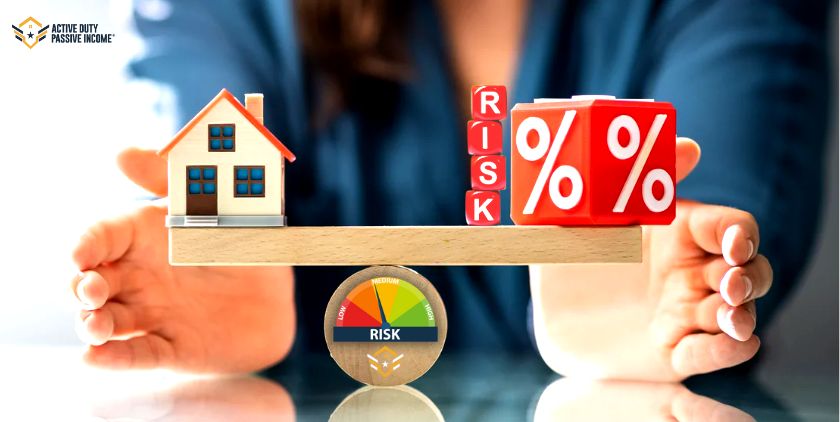Risk Tolerance in real estate is an important factor to consider when you are looking to start from scratch or further your real estate investments.
Hello, fellow real estate investors! Today, we will be discussing an essential topic for any successful career in real estate: risk tolerance. As you plan for your retirement and aim to hit your Military Financial Freedom Number, investing in real estate can be a great way to diversify your portfolio and secure long-term financial stability.
However, it also comes with its share of challenges, and being able to evaluate and consider the risks that come with each investment opportunity is crucial. Think about how one investment affects another, what your next purchase will be, what does each investment gain you long-term, are there possible hidden fees and obligations? I know it’s a lot but don’t worry, we’ll make it as entertaining and helpful as possible. Let’s get started!

What Is Risk Tolerance?
At its most basic level, risk comes from not having enough resources to meet a specific requirement. If you make $4,2000 a month and you decide to buy a house that has a mortgage of $4,000 a month, the slim margin between income and expenses makes that a risky financial decision. When talking about real estate investing, risk tolerance is all about how many problems (a.k.a. volatility) you’re willing to take on as an investor. Are you the type of person who enjoys a challenge and likes to find solutions to problems? Or are you the type of person that likes to deal with the smallest number of problems when it comes to investments, and will pay a premium for that peace of mind? Your answer to this question will give you an idea of where you fall on the risk tolerance spectrum. You must be sure to understand your personal investor DNA and risk tolerance as you look at building your real estate portfolio.
Types of Risk Tolerance
There are three types of risk tolerance: aggressive, moderate, and conservative. Aggressive investors are generally considered daredevils who love taking risks or taking on problems. They’re the type of people who would invest in a property without even checking its foundation and deal with any issues that pop up as long as the payout was large enough. Conservative investors are like overprotective parents who won’t let their kids go outside without a helmet and knee pads. They like steady returns over the long haul with minimal problems and are willing to accept less profit to have that insurance. Moderate investors take on some risk, but they also try to balance it out with some caution. Many times, a moderate investor is simply a conservative investor that must move quickly on a deal and not have enough time to put all their risk controls in place. Normally, the higher the risk, the higher the potential reward and the same investor can be at different risk levels across the different deals in their portfolio.
Why Is Risk Tolerance Important in Real Estate?
Knowing your risk tolerance is important because it helps guide investment decisions that you are comfortable with. If you know you’re a conservative investor, you’re less likely to take on too much risk and potentially lose money. On the other hand, if you’re an aggressive investor, you might miss out on opportunities if you don’t take risks. Risk tolerance also influences the types of deals that people will bring to you. For example, if you are known to be a more conservative investor, then the riskier deals may not even come your way. Keep in mind, when it comes to retirement or where you are in the journey of meeting your overall goals, your risk tolerance might shift, so make sure to review your portfolio regularly to ensure it aligns with your retirement goals. So, know your personal risk tolerance, invest smartly, and let those sweet, sweet deals come to you!
What Factors Affect Real Estate Risk Tolerance?
Your risk tolerance is determined by several factors such as your age, income, credit, financial objectives, and personal experience. Younger individuals with a stable income may be more inclined to take risks since they have more time to bounce back from any potential losses. As we age and acquire more obligations (i.e. – family and a mortgage), investors tend to become less inclined to endure the uncertainty associated with high-risk investments. For those nearing retirement with limited savings, a conservative approach may be more suitable as they cannot afford to risk losing money.
How Risk Tolerance Affects Investing Goals
A time horizon is a major factor in determining risk tolerance. As you consider your investment goals, the timing of the returns can make a huge difference. If you’re an aggressive investor, you might have a goal of making high returns quickly, like if your investing strategy is flipping houses and it costs you money to hold on to the property. But if you’re a conservative investor, you might have a goal of preserving your capital and making slow, steady gains over time and are more inclined to gravitate towards a buy and hold strategy to acquire properties in your portfolio.
When do investors need to Assess Risk Tolerance?
Investors need to continually assess their risk tolerance before and during any investment. It’s important to know your personal risk tolerance so you can choose investments that are appropriate for you. For example, if you’re a conservative investor, you might not want to invest in a property that’s in a high-risk area for crime or floods. Similarly, you need to consider the impacts of changing your portfolio as new investment opportunities come along and you weigh the opportunity cost of holding on to your current homes against the potential increase from buying new properties.
Example of a 60/40 Portfolio Structure
One way to balance risk and return is to create a diversified portfolio that includes both stocks and real estate. For example, a 60/40 portfolio structure might include 60% stocks and 40% real estate. This way, you’re not putting all your eggs in one basket. This can also be applied to different asset classes inside of real estate. You may want to invest in flipping single family homes as the majority of your portfolio, but also invest with other operators in an assisted living services property or mobile home community.
Risk Tolerance vs Risk Capacity
It’s crucial to review that personal risk tolerance differs from risk capacity, which is the amount of risk you can afford to take on based on your financial situation. Your risk capacity is determined by various factors like your home equity, market trends, and your overall financial obligations. If you have substantial debt or dependents to support, you may not be able to take on as much risk as someone who has no debt and no dependents, regardless of your risk tolerance.
With terminology knocked out in the information above I want to go over some of the creative ways over the years that all of us and our partners have sat around and talked about when it comes to analyzing overall risks! With many personalities there are some of our investors who have a goal in mind and are sticking to their 10-15 year plan and do not deviate from it. With some of our beginner investors we see them choosing to grow slower as they maybe buying for the first time and they are reading every single word on the paperwork, learning what fees can and should be on the loan, learning functionality of a loan officer and the title company, setting up management and just a true overall understanding of the entire process. What I have seen with this system is that the first one may go in a particular direction the next purchases one after another are expertly executed, with education and instruction and the investor is able to key in on deals as soon as they pop up on the market!
We have others who have executed several in a short period of time and work backwards to get everything in order to rent them out, flip them, short term rent them, etc. These people are typically our personalities who love chaos! They seem to thrive in a full day’s work trying to manage everything at once.
In both of these situations people become educated about their tolerance and their ability to deal with projects and growth. Becoming an investor is an amazing journey to go on, being able to asses your risk constantly will allow you to grow quicker and more confiently. Risk is not just about numbers. It is about numbers, time, management skills, the ability to deal with problem solving and much much more. As you asses your personal risk levels make sure to make it a habit and make sure to do it often so you can continue to grow and truly identity when the best time to lean into buying and when the best time to learn into continuing to get educated. There is a season for everything! Make your time count!
ADPI Pro Tips
- Same deal, different risk. As you gain experience over time and more resources, the characterization of risk changes on the same deal. Investors with a stronger financial position and a large network of related businesses providing discounted services (i.e.- property managers, agents, and contractors), have a much higher capability to deal with volatility and problems than newer investors. In other words, a deal that is risky for one investor may not be the same level of risk for another.
- Regardless of risk tolerance, always minimize risk: Due diligence is critical when investing in a property. It’s essential to take the time to conduct a thorough investigation into its condition, history, and potential. Hire an inspector to assess the property’s structure and systems, review the property’s rental history and vacancy rates, and research the local housing market and trends. Be sure to factor in the cost of any necessary repairs or upgrades into your overall investment strategy.
- Diversify your portfolio: Like any investment, real estate carries inherent risks, and it’s essential to diversify your portfolio to spread out your risk. Consider investing in different types of properties, such as residential, commercial, or industrial. You can also invest in properties in different locations to spread out your geographic risk. Additionally, consider investing in real estate investment funds like ADPI Capital™ Equity Fund 1™ to have a team of professionals help diversify your portfolio and gain exposure to a broader range of properties and markets.
This blog was written in collaboration with our absolutely amazing DoD SkillBridge employee: Seneca










